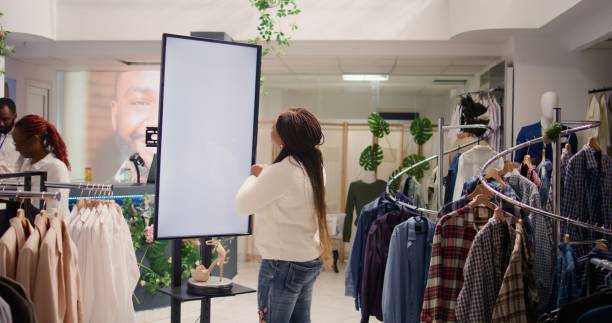In a world where shopping online often ends with disappointment…
Smart mirrors might be the missing link between screen and style.
From virtual try-ons to AI-driven fit suggestions — from real-time lighting adjustments to personalized styling cues…
Smart mirrors are changing how we shop — and how confident we feel before clicking “buy.”
In this guide, we’ll explore:
- Why fit remains fashion’s biggest digital challenge
- How smart mirrors build emotional safety and trust
- Real-world examples from TikTok Shop to Shopify
- And what psychology says about how people respond to visual clarity
Let’s dive into Are Smart Mirrors the Future of Online Fashion Retail? — and discover why sometimes, the best way to sell clothes isn’t through pictures…
It’s through reflection.
The Emotional Gap in Online Fashion: Why Fit Feels Risky
We assume that product images sell fashion — but research shows otherwise.
According to MIT Sloan Review , over 40% of clothing returns happen because the item doesn’t match expectations — not because it’s low quality.
That means:
Your visuals aren’t selling — they’re raising doubt .
Because real conversion doesn’t come from beauty shots alone…
It comes from visual confidence .
And that’s where smart mirrors step in.
5 Reasons Smart Mirrors Could Change Fashion eCommerce Forever
Here’s how this tech could finally solve fashion’s most persistent problem.
🧠 1. Virtual Try-Ons That Reduce Return Rates
Instead of guessing if something fits — shoppers can now see themselves in real time using AR-enabled mirrors.
This reduces uncertainty — and makes them more likely to keep the purchase.
Because in digital commerce…
Seeing yourself wins over seeing models.
🛍️ 2. Personalized Styling Without Guessing
AI-powered smart mirrors learn from past purchases — then suggest:
- Similar fits
- Matching accessories
- Complementary colors
Which builds brand loyalty — and increases average order value.
Because real personalization doesn’t come from data alone…
It comes from reflection , both literal and emotional.
📱 3. Live Feedback Loops for Social Shopping
Some smart mirrors now integrate with TikTok, Instagram, or WhatsApp — letting users share their look instantly.
They send a photo to a friend — or even a stylist bot — and get feedback before buying.
Which means:
Shoppers don’t just see themselves — they confirm their choice socially.
And that makes all the difference.
🧬 4. Lighting Adjustments That Match Real Life
Ever bought something that looked perfect on-screen — only to hate it at home?
Smart mirrors adjust for lighting conditions — showing items under natural light, office glow, or evening ambiance.
Which builds realism — and reduces buyer’s remorse.
Because in digital fashion retail…
Clarity sells better than color correction.
🤖 5. AI That Learns From Every Interaction
Top-performing brands are integrating smart mirror data into their AI systems.
So instead of one-size-fits-all recommendations…
They offer: ✅ “People like you usually prefer size L.”
✅ “Based on your past purchases, this will match your style.”
One feels automated.
The other feels intentional.
And that’s exactly what modern shoppers crave.
Real-Life Examples: When Smart Mirrors Helped Stores Convert Better
Let’s look at real cases where smart tech turned hesitation into sales.
👗 Case Study 1: The Fashion Brand That Cut Returns by 35%
A direct-to-consumer apparel store added a smart mirror integration via Vue.ai .
Shoppers could:
- Upload body type
- See realistic fit
- Preview outfits together
Result?
- 35% drop in return rate
- Higher customer satisfaction
- More repeat buyers
💡 Why It Worked: They gave control back to the shopper — and reduced guesswork.
📱 Case Study 2: The TikTok Seller Who Used Smart Mirror Tech in Live Sales
An influencer-backed fashion brand tested live shopping with smart mirror integration.
During streams, viewers saw:
- Real-time outfit changes
- Fit suggestions based on body shape
- Lighting-adjusted visuals
She said:
“I thought visuals would win — turns out, confidence did.”
💡 Lesson Learned: Confidence in appearance beats curiosity every time.
🧑💼 Case Study 3: The Amazon Storefront That Used Mirror Data to Improve Recommendations
Amazon integrated smart mirror insights into its recommendation engine — and started suggesting:
- True-to-body styles
- Based on past purchases
- With lighting-based accuracy
Result?
- Higher AOV (average order value)
- Lower cart abandonment
- Fewer negative reviews
💡 Why It Mattered: They didn’t just show products — they showed realistic outcomes .
How Smart Mirrors Work Across Platforms
Want to build trust through reflection — and reduce return losses?
Here’s how different platforms are using smart mirrors — and what works best.
📲 1. Shopify & Third-Party Integrations
Shopify has begun partnering with AI fitting tools like:
- Virtusize
- Vue.ai
- Fits.me
These integrations let shoppers compare current items with their own measurements — reducing mismatched expectations.
Because real confidence builds when you know what you’re getting.
📦 2. Amazon Fashion & Body Mapping Tech
Amazon’s smart mirror experiment used body scanning to recommend sizes — and even fabric types.
Buyers could preview:
- How an item looks on their body
- In different settings
- Under real-life lighting
Which made them far less likely to return — and more likely to reorder.
Because real fashion isn’t just about style — it’s about feeling right in what you wear.
🎥 3. TikTok Shop & Influencer-Backed Visual Fittin
TikTok Shop creators are testing smart mirror integrations during live streams.
Fans can:
- See how clothes hang
- Ask about movement and stretch
- Get real-time styling tips
Which builds trust — and increases impulse buys.
Because in short-form commerce…
Seeing is believing — especially when influencers help prove it.
🧾 4. Etsy & Niche-Level Fit Accuracy
Artisan sellers on Etsy are starting to use smart mirror tech to:
- Show handmade garments on diverse bodies
- Highlight texture and drape
- Offer customization suggestions
Even though it’s niche, the shift is clear.
Because real handmade value needs real proof — especially when shipping internationally.
🚫 5. Dropshipping Brands & Scalper Bot Defense
Some dropshippers are using smart mirror tech to fight back against bots and fake claims.
By offering:
- Verified fit reports
- Identity-linked returns
- AI-powered fraud checks
They’re reducing losses — and increasing customer satisfaction.
Because real growth isn’t built on volume — it’s built on security and sustainability .
Frequently Asked Questions (FAQ)
Q: Should I invest in smart mirror tech for my store?
A: Yes — especially if you sell high-ticket or tailored fashion.
Q: Do customers really care about accurate fit previews?
A: Definitely — studies show shoppers who use smart mirrors convert faster and return less.
Q: Will smart mirrors replace mannequins?
A: Not fully — but they’ll become the new standard for personalized visualization .
Q: Can AI improve mirror-generated suggestions?
A: Yes — with machine learning, mirrors can evolve with each interaction.
Q: What’s the safest way to implement smart mirrors?
A: Start with third-party tools — then move to embedded versions as adoption grows.
Final Thoughts
Fashion has never been just about fabric — it’s about feeling seen.
Because in digital retail…
Sales impress. Fit sustains. And certainty retains.
So next time you’re updating your store or optimizing your funnel…
Don’t just ask:
“What do they want?”
Ask:
“How can they see themselves in it?”
Because the strongest moves in online retail…
Aren’t made from scarcity.
They’re made from clarity .
And sometimes, the best way to earn a sale…
Isn’t by pushing harder.
It’s by letting them reflect longer — and buy with confidence.










